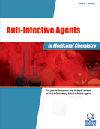- Home
- A-Z Publications
- Anti-Infective Agents in Medicinal Chemistry (Formerly Current Medicinal Chemistry - Anti-Infective Agents)
- Previous Issues
- Volume 9, Issue 1, 2010
Anti-Infective Agents in Medicinal Chemistry (Formerly Current Medicinal Chemistry - Anti-Infective Agents) - Volume 9, Issue 1, 2010
Volume 9, Issue 1, 2010
-
-
Generation and Analysis of Interaction Energy Maps of p-Substituted Benzoic Acid N'-(5-Nitrothiophen-2-yl)Methylenehydrazides Active Against Multidrug-Resistant Staphylococcus aureus
More LessAuthors: Andrea Masunari, Ieda Y. Sonehara and Leoberto Costa TavaresStudies in 3D molecular fields generally contain a large amount of data, some of which are redundant or not relevant. The program Volsurf, a quite fast method, is able to compress the relevant information present in 3D molecular structures into a few descriptors that represent the physicochemical properties. In this study eighteen p-substituted benzoic acid N'-(5-nitrothiophen-2-yl)methylenehydrazides with antimicr Read More
-
-
-
Effective Antimicrobial and Anti-Endotoxin Activity of Cationic Peptides Based on Lactoferricin: A Biophysical and Microbiological Study
More LessBacterial endotoxins (lipopolysaccharide, LPS) from the outer leaflet of the outer membrane of Gram-negative bacteria are among the most effective natural compounds in triggering the human innate immune system. This may be beneficial at low but pathophysiological at high LPS concentrations, the latter leading to the severe septic shock syndrome with still high mortality rates especially in intensity care units. On Read More
-
-
-
From Vancomycin to Oritavancin: The Discovery and Development of a Novel Lipoglycopeptide Antibiotic
More LessThe introduction of penicillin in the 1940s, erythromycin in the 1950s and methicillin in the 1960s was quickly followed in each case by appearance of resistance to these antibiotics. By comparison, glycopeptide resistance required nearly thirty years to appear following clinical introduction of vancomycin. The reason for the delay is likely related to the clever mechanism of action of glycopeptide antibiotics. These antibiotics int Read More
-
Most Read This Month
Article
content/journals/aiamc
Journal
10
5
false
en


